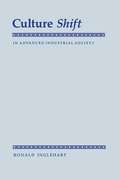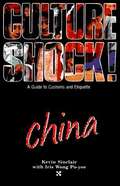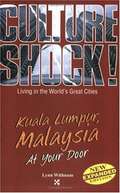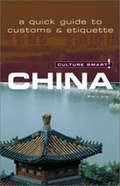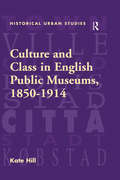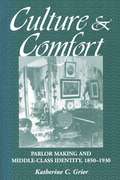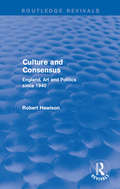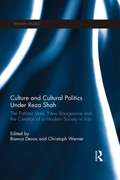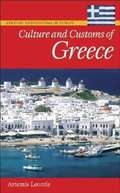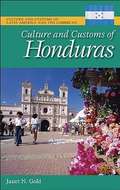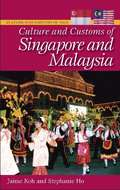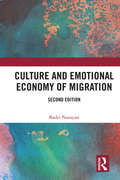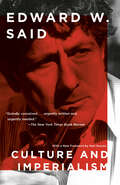- Table View
- List View
Culture Shift In Advanced Industrial Society
by Ronald InglehartEconomic, technological, and sociopolitical changes have been transforming the cultures of advanced industrial societies in profoundly important ways during the past few decades. This ambitious work examines changes in religious beliefs, in motives for work, in the issues that give rise to political conflict, in the importance people attach to having children and families, and in attitudes toward divorce, abortion, and homosexuality. <p><p>Ronald Inglehart's earlier book, The Silent Revolution (Princeton, 1977), broke new ground by discovering a major intergenerational shift in the values of the populations of advanced industrial societies. This new volume demonstrates that this value shift is part of a much broader process of cultural change that is gradually transforming political, economic, and social life in these societies. <p><p> Inglehart uses a massive body of time-series survey data from twenty-six nations, gathered from 1970 through 1988, to analyze the cultural changes that are occurring as younger generations gradually replace older ones in the adult population. These changes have far-reaching political implications, and they seem to be transforming the economic growth rates of societies and the kind of economic development that is pursued.
Culture Shock! Borneo
by Heidi MunnWhether you travel for business, pleasure, or a combination of the two, the ever-popular "Culture Shock!" series belongs in your backpack or briefcase. Get the nuts-and-bolts information you need to survive and thrive wherever you go.
Culture Shock! China
by Kevin Sinclair Iris W. Po-YeeThis book tells you everything you need to know about daily life in several cities, specifically China.
Culture Shock! Kuala Lumpur, Malaysia at Your Door
by Lynn WithamWhether you are conducting business, traveling for pleasure, or even relocating abroad, one mistake with customs or etiquette can leave a bad taste in everyone's mouth. International travelers, now more than ever, are not just individuals from the United States, but ambassadors and impression makers for the country as a whole. Culture Shock! country and city guides make up the most complete reference series for customs and etiquette you can find. These are not just travel guides, they are guides for a way of life!
Culture Smart! China
by Kathy FlowerA quick, accurate guide to customs and etiquette for visitors going to China.
Culture Under Canvas: The Story of Tent Chautauqua
by Harry P. Harrison Karl DetzerIn 1904, a showman and Redpath Leyceum Bureau manager named Keith Vawter, put the main forms of entertainment of the time—comedy and culture—on the same platform in a travelling tent, “marrying the respectability of the Lyceum to the spangles of the stage,” and named the union “Chautauqua,” after an institution established permanently on Chautauqua Lake, New York.For the next thirty years, Chautauqua tents rolled back and forth and up and down America, pitching in pastures, school yards and courthouse squares. “They offered not only the soaring oratory of a William Jennings Bryan, but also music, drama, magic, art lessons, cooking classes, low comedy and high-minded debates. Millions of eager listeners under the “big top” canvas, hot with summer’s sun, perspired freely and soaked up both erudition and amusement.”This book, first published in 1958, takes a close look at the movement that allowed men to talk freely from this new informal platform, abandoning nineteenth-century taboos.
Culture and Civilization: Volume 2, Beyond Positivism and Historicism
by Irving Louis HorowitzThis second volume in this new series aims to anchor the 21st century in the tradition of the new, to raise methodology into historiography. As the new millennium develops, it is becoming evident that science and society are critical pivots in the formation of a larger mosaic of culture and civilization. A tradition has developed and refuses to dissolve under the withering aspect of analysis. Whether flying under the banner of Arthur Lovejoy, George F. Kennan, Pitirim Sorokin, Arnold Toynbee, Alexander Solzhenitsyn, T. S. Eliot, Thorstein Veblen, and countless others, it has become clear that making sense of the whole, and not resting easy with bits and pieces has become the mission of Culture & Civilization.This second volume expands upon the initial efforts to deepen the sense of tradition, with outstanding contributions ranging from Charles Murray, The Happiness of the People; Peter Watson, Ideas: A History of Thought from Fire to Freud; Evan Selinger, Ethics and Poverty Tours; Walter A. McDougall, American Policy Traditions in the Middle East; Raymond Ibrahim, Violence in Judaism, Christianity and Islam; Michael Curtis, Israel: Land, Law, and Legitimacy; Marian Tupy, Persistent Poverty in Africa; David Ronfeldt and Danielle Varda, Cyberocracy Revisited; a retrospective by Leo Alexander on Medical Science under Dictatorship; and a series of brilliant new essays on Wyndham Lewis, Jonathan Swift, Max Scheler, and Thurman Arnold.Culture and Civilization does not embrace idiosyncratic visions of the apocalypse or the end of Western empires. It does attempt to bring together immediate issues and ideas that are substantial and challenging. The essential polarity between democracy and autocracy has now taken on historical dimensions that has now taken on larger, deeper dimensions in different political economic, and ecological terrain of our day is civilization versus barbarism. This second volume is a sober, deeper response to such a challenge.
Culture and Class in English Public Museums, 1850-1914 (Historical Urban Studies Series)
by Kate HillThe nineteenth century witnessed a flowering of museums in towns and cities across Britain. As well as providing a focus for collections of artifacts and a place of educational recreation, this work argues that municipal museums had a further, social role. In a situation of rapid urban growth, allied to social and cultural changes on a scale hitherto unknown, it was inevitable that traditional class and social hierarchies would come under enormous pressure. As a result, urban elites began to look to new methods of controlling and defining the urban environment. One such manifestation of this was the growth of the public museum. In earlier centuries museums were the preserve of learned and respectable minority, yet by the end of the nineteenth century one of the principal rationales of museums was the education, or 'improvement', of the working classes. In the control of museums too there was a corresponding shift away from private aristocratic leadership, toward a middle-class civic directorship and a growing professional body of curators. This work is in part a study of the creation of professional authority and autonomy by museum curators. More importantly though, it is about the stablization of middle-class identities by the end of the nineteenth century around new hierarchies of cultural capital. Public museums were an important factor in constructing the identity and authority of certain groups with access to, and control over, them. By examining urban identities through the cultural lens of the municipal museum, we are able to reconsider and better understand the subtleties of nineteenth-century urban society.
Culture and Comfort: Parlor Making and Middle-Class Identity, 1850-1930
by Katherine GrierIn Culture and Comfort Katherine C. Grier shows how the design and furnishings of the mid-nineteenth century parlor reflected the self-image of the Victorian middle class. Parlors provided public facades for formal occasions and represented an attempt to resolve the often opposing ideals of gentility and sincerity to which American culture aspired. The book traces the fortunes of the parlor and its upholstery from its early incarnations in "palace" hotels, railroad cars, steamships, and photographers' studios; through its mid-century heyday, when even remote frontier homes could boast "suites" of red plush sofas and chairs; to its slow, uneven metamorphosis into the more versatile living room. The author argues that even as the home increasingly was seen as a haven from industralization and commercialization, its ties to industry and commerce--in the form of more affordable, machine-made furniture and drapery--became stronger.By the 1920s the parlor's decline signaled both a blurring of the Victorian distinctions between public and private manners and the transfer of middle-class identity from the home to the automobile. Describing the deportment a parlor required, the activities it sheltered, and the marketing and manufacturing breakthroughs that made it available to all, Culture and Comfort reveals the full range of cultural messages conveyed by nineteenth-century parlor materials.
Culture and Consensus: England, Art and Politics since 1940 (Routledge Revivals)
by Robert HewisonCulture and Consensus, first published in 1995 and a revised edition in 1997, explores the history of the relationship between politics and the arts in Britain since 1940, and shows how the search for a secure sense of English identity has been reflected in official and unofficial attitudes to the arts, architecture, landscape and other emblems of national significance. Illustrating his argument with a series of detailed case histories, Robert Hewison analyses how Britain’s cultural life has reached its present enfeebled condition and suggests a way forward. This book will be of interest to students of art and cultural studies.
Culture and Consumption
by Gabriel R. RicciThis is the thirty-first volume in Religion and Public Life, formerly This World, a series on religion and public affairs. This ongoing series seeks to provide a wide-ranging forum for differing views on religious and ethical considerations. The essays grouped together in Culture and Consumption discuss the phenomenon of consumption, an identifiable and pervasive feature of American culture that distinguishes it from other national cultures. The lead article provides an insight into the long-standing pattern of consumption that has been progressively elevated into social policy in America. This is a balanced analysis of the history of the consumption cultural ethos beginning with the undermining of the Native American Culture and ending with Wilsonian Liberal-Internationalism and the demise of the moral authority of organized labor. This commercialization of culture has always competed with the funding vision of a dispassionate social order in which custom, deferential politics, and continuation of traditional hierarchal values would be the constitutional agenda. Another contributor argues that the emergence of the democratic-consumer state in America was anticipated in de Tocqueville's observation that "in democracies nothing has brighter luster than commercea." Other contributor essays treat issues such as the New Class and the consumer state; technology's triumph at the expense of the social and natural worlds; and argue against the materialist perspective in addiction. Culture and Consumption includes the following major contributions: "The Dialectic of Consumption: Materialism and Social Control" by David Brown; "Religion, Social Science and the Ironies of Parasitic Modernity" by Guy Alchon; The Dilemma of Hypermodernity" by Mark Wegierski; "Toward an Epistemology of Addiction" by Leonard Kaplan and Vince Rinella. Also included are book reviews by Martha Davis and Conrad Kanagy. In a concluding essay, Gabriel Ricci reviews Jerome Bruner's The Culture of Education. Culture and Consumption is part of an annual survey of religion and public life that provides relevant information and ideas about significant issues of the day.
Culture and Cultural Politics Under Reza Shah: The Pahlavi State, New Bourgeoisie and the Creation of a Modern Society in Iran (Iranian Studies)
by Christoph Werner Bianca DevosCulture and Cultural Politics Under Reza Shah presents a collection of innovative research on the interaction of culture and politics accompanying the vigorous modernization programme of the first Pahlavi ruler. Examining a broad spectrum of this multifaceted interaction it makes an important contribution to the cultural history of the 1920s and 1930s in Iran, when, under the rule of Reza Shah Pahlavi, dramatic changes took place inside Iranian society. With special reference to the practical implementation of specific reform endeavours, the various contributions critically analyze different facets of the relationship between cultural politics, individual reformers and the everyday life of modernist Iranians. Interpreting culture in its broadest sense, this book brings together contributions from different disciplines such as literary history, social history, ethnomusicology, art history, and Middle Eastern politics. In this way, it combines for the first time the cultural history of Iran’s modernity with the politics of the Reza Shah period. Challenging a limited understanding of authoritarian rule under Reza Shah, this book is a useful contribution to existing literature for students and scholars of Middle Eastern History, Iranian History and Iranian Culture.
Culture and Customs of France (Culture And Customs Of Europe Ser.)
by W. Scott HaineThe French are of perennial interest, for, among other things, their style, cuisine, wine, and cultural output. Culture and Customs of France is a thoroughly jam-packed narrative through the glories that France continues to offer the world. The volume is a boon for preparing country reports, a must-read for travelers, and perfect for culture studies. Chapters on the land, people, and history, religion, social customs, gender, family, and marriage, cinema and media, literature, food and fashion, architecture and art, and performing arts are current and pleasurable to read.
Culture and Customs of Greece
by Artemis LeontisLeontis presents an overview of the culture and traditions of Greece that is aimed at general readers and students. He provides information on the land, people, history, religion, society, leisure, holidays, food, language and literature, music and dance, media, theater, cinema, and architecture and art of the country, focusing on the language as the center of the culture. Annotation ©2009 Book News, Inc., Portland, OR (booknews.com)
Culture and Customs of Honduras
by Janet N. GoldFor students and general readers, Gold (Latin American literature, U. of New Hampshire) describes the culture and customs of Honduras. She covers the country's national identity and regional and linguistic diversity, indigenous peoples, religion, daily life, food, dress, sports, media, literature and oral tradition, traditional artistry and handcrafts, and visual and performing arts. She includes information about individuals and contributions not easily accessible in English and gives less attention to topics extensively documented in English elsewhere, such as the Mayan civilization of Copán. Annotation ©2009 Book News, Inc., Portland, OR (booknews.com)
Culture and Customs of Laos
by Arne KislenkoKislenko (history, Ryerson U., Canada) presents general readers with this overview of the geography, history, culture, and customs of Laos. A chronology opens the text, followed by chapters on religion and thought; literature; art; architecture and design; theater, dance, music, and film; cuisine and traditional dress; gender, courtship, marriage, and family; festivals; and social customs. A glossary and a chronology of Lao Kings supplement the text. Annotation ©2009 Book News, Inc., Portland, OR (booknews.com)
Culture and Customs of Singapore and Malaysia
by Jaime Koh Stephanie HoJamie Koh is a former journalist and writer who specializes in Asian history and culture, and she teams with former history teacher and museum educator Stephanie Ho to present students and general readers with this survey of the cultures and customs of Singapore and Malaysia. The authors provide chapters on religious thought, the arts, entertainment, housing and architecture, food and fashion, marriage and family life and leisure activities in these two independent yet closely related countries. A concluding chapter on the future of Singapore and Malaysian culture addresses the impact of modernization and globalization as well as this region's demographic shift toward multiculturalism. Annotation ©2009 Book News, Inc., Portland, OR (booknews.com)
Culture and Customs of the Arab Gulf States
by Rebecca L. Torstrick Elizabeth FaierTorstrick and Faier present a concise volume for students and general readers focusing on contemporary culture and life of the Arab Gulf countries, within an historical context. The authors seek to dispel the stereotypical ideas about the Arab Gulf states by introducing readers to the richness and diversity of life in these countries. The text includes a chronology followed by chapters on the land, people and a brief historical overview; religion and world view; literature and media; settlement, architecture, and material culture; food, dress, and personal adornment; gender, marriage, and family; customs, folklore, and daily life; and music and dance. Also included are a glossary of terms, a bibliography of print materials, and list of useful websites for readers interested in additional information. Torstrick teaches anthropology at Indiana U., South Bend; formerly with Zayed U. in Dubai, Faier is currently an independent scholar with an educational background in cultural anthropology. Annotation ©2009 Book News, Inc., Portland, OR (booknews.com)
Culture and Customs of the Netherlands
by John RoneyRoney (history, Sacred Heart U., Fairfield, Connecticut) presents an introductory overview of the culture and customs of the Netherlands, for students and general readers. Through eight chapters, Roney examines the geography, people, and history of the country; religious choices and philosophies; social and lifestyle issues regarding health and social welfare, tolerance for problems and controversial issues (prostitution and sex trade, euthanasia, reproductive rights, sexual orientation choices, drugs), family, gender, and education; holidays and leisure; housing; cuisine and fashion; literature from the medieval and Renaissance periods to the present day; performing arts and media; and the country's rich visual arts history.
Culture and Defence in Brazil: An Inside Look at Brazil's Aerospace Strategies (Military Strategy and Operational Art)
by Maria Filomena Fontes RiccoThis volume examines the connection between culture and defence by providing an inside look at Brazil’s aerospace strategies. Brazil is becoming increasingly important geopolitically, and several studies have sought to further understanding of this new position in the international arena. This volume aims to provide a better understanding of the Brazilian nation, its security dilemmas, and how the country seeks to develop its defence training process and improve its professional military education. Organised into two parts, the chapters offer academic dialogues on several aspects of this topic, including public politics and the law, joint operations, human factors and the government interchanges with industry. The first section analyses Brazilian defence policy and strategy, discussing different aspects of aerospace power and Brazilian security perspectives. Chapters discuss the relationship between Brazil and the United States, which blend aspects of the generation of knowledge, science, technology and innovation, and point to economic issues and the Defence Industrial Base. Specific implications of the Brazilian air space, compared with Europe and the United States, also are exposed. In addition, a vision of cyberspace implications for the national power, a present-day question for the entire planet, is also presented. Thereafter, the second section looks at specific aspects of professional military education and explains the Brazilian approach to strengthening its aerospace power. This includes military education and performance, interdisciplinary studies, working jointly, multivariate analysis and cases. This book will be of much interest to students of military studies, defence studies, gender issues, crises management and decision making, Latin American politics and International Relations in general.
Culture and Development: A Critical Introduction
by Jane Haggis Susanne SchechThis book introduces students to new ways of thinking about development. It integrates the recent scholarship of cultural studies within the existing frameworks of development studies, which have primarily focused on issues of political economy and structural transformation.
Culture and Economy: The Shaping of Capitalism in Eastern Asia
by Timothy Brook Hy V. LuongIn recent years, most of the economies of Eastern Asia have been absorbed into global capitalism. Capitalism has transformed these economies, but the process has not been one-way. The cultures of Eastern Asia have in turn shaped how capitalism organizes labor, capital, and markets in ways that could not have been anticipated even ten years ago. On the basis of rich empirical analyses of East and Southeast Asia, and with theoretical insights from different approaches in the social sciences, Culture and Economy addresses these issues in both macroscopic and microscopic terms. Specific topics discussed range from the use and reinvention of Confucian and Islamic legacies in South Korea and Malaysia to promote a particular vision of the economy, to the role of family- and network-structured firms and the reliance on trust-based personal networks in Southeast Asia, to the cultures of labor and management in Chinese village enterprises and Vietnamese ceramics firms, as well as in South Korean export processing zones and the current Chinese labor market. These careful case studies suggest that it is inevitable that Eastern Asia will shape, even remake, capitalism into a system of production and consumption beyond its original definition. Timothy Brook is Professor of History, Stanford University. Hy V. Luong is Professor of Anthropology, University of Toronto.
Culture and Emotional Economy of Migration
by Badri NarayanThis book studies how the act of migration is a motivating constituent in the production of popular culture in both the homeland and the destination. It looks at the formations of cultures in the process of identity-making of approximately 200 million Indians scattered across the world, from colonial to contemporary times. The volume is an in-depth exploration of the flow of cultures and their interactions through a study of north Indian migrants who underwent two waves of emigration – from the Bhojpuri region to the Dutch colony of Suriname between 1873 and 1916 to work on sugar, coffee, cotton and cocoa plantations, and their descendants who moved to The Netherlands following the Surinamese independence in 1975. It compares this complex network of cultures among the migrants to the folk culture of the Bhojpuri region from where large-scale migration is still taking place. The work draws on archival records, secondary literature, folk songs, rare photographs, and extensive fieldwork across continents – the Bhojpuri region, Mumbai, Surat and Ghaziabad in India, and Suriname and The Netherlands. This second edition marks the 150th Anniversary of the Abolition of Indentured Labour. With a new prologue, an updated introduction and some revisions to the text, it will be useful to scholars and researchers of cultural studies, labour studies, sociology, modern Indian history, migration and diaspora studies. It will also interest the Indian diaspora, especially in Europe and the Americas.
Culture and Health Disparities: Evaluation of Interventions and Outcomes in the U.S.-Mexico Border Region (SpringerBriefs in Public Health)
by John G. BruhnThe sister cities of the southwestern United States border are challenged by widespread environmental and health issues and limited access to help. And while different initiatives have been set up to improve health outcomes and lessen inequities in the border region, evaluation data are scarce. Culture and Health Disparities provides a perspective on U. S. -Mexico border health with an evidence-based guide for conceptualizing, implementing, and evaluating health interventions. Taking into account the unique qualities of border life and their influence on general wellbeing, this important volume offers detailed criteria for creating public health programs that are medically, culturally, and ethically sound. The book identifies gaps in intervention research on major health concerns in the area, relating them to disparity-reduction efforts in the rest of the U. S. and arguing for more relevant means of data gathering and analysis. The author also asserts that progress can be made on both sides of the border despite concurrent social and political problems in the region. Included in the coverage: The border region as a social system. The development of health disparities: a life-course model. A social systems approach to understanding health disparities. A critique of U. S. -Mexico border health interventions. Evaluating interventions to reduce healthcare disparities. Ethical issues in health interventions across cultures and contexts. A text for researchers and practitioners working to promote border health and reduce service inequalities, Culture and Health Disparities asks pertinent questions and provides workable, meaningful answers.
Culture and Imperialism
by Edward W. SaidA landmark work from the author of Orientalism that explores the long-overlooked connections between the Western imperial endeavor and the culture that both reflected and reinforced it."Grandly conceived . . . urgently written and urgently needed. . . . No one studying the relations between the metropolitan West and the decolonizing world can ignore Mr. Said's work.' --The New York Times Book ReviewIn the nineteenth and early twentieth centuries, as the Western powers built empires that stretched from Australia to the West Indies, Western artists created masterpieces ranging from Mansfield Park to Heart of Darkness and Aida. Yet most cultural critics continue to see these phenomena as separate. Edward Said looks at these works alongside those of such writers as W. B. Yeats, Chinua Achebe, and Salman Rushdie to show how subject peoples produced their own vigorous cultures of opposition and resistance. Vast in scope and stunning in its erudition, Culture and Imperialism reopens the dialogue between literature and the life of its time.
